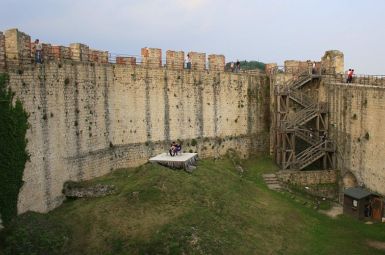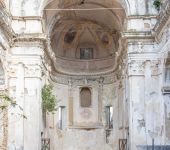
Bussana Vecchia: D’Inverno, Il “Borgo degli Artisti” Si Trasforma nel Magico Villaggio di Babbo Natale

Cari lettori de I borghi d’Italia.com, c’è un luogo in Liguria dove l’arte non è solo esposta, ma è intrinseca in ogni pietra. Un borgo fantasma risorto grazie al genio creativo, che, nel silenzio ovattato dell’inverno, assume un fascino fiabesco, quasi fosse il nascondiglio segreto di Babbo Natale in Italia: parliamo di Bussana Vecchia.
Soprannominato affettuosamente il “Borgo degli Artisti”, Bussana Vecchia non è semplicemente un paese, ma una testimonianza vivente di resilienza e bellezza. Abbandonato dopo il violento terremoto del 1887, questo mucchio di rovine venne riportato in vita a partire dagli anni ’60 da una comunità di artisti, artigiani e sognatori provenienti da tutto il mondo.
❄️ Il Fascino Unico: Un Silenzio d’Oro che Sa di Magia
Se d’estate Bussana Vecchia è animata da turisti e da un fermento creativo costante, è durante i mesi invernali che rivela la sua anima più profonda e spettacolare.
Quando il sole è basso e l’aria si fa frizzante, il borgo assume un aspetto unico:
- Le Luci Calde: I laboratori artigiani, pur riducendo gli orari, lasciano filtrare dalle finestre piccole luci gialle e arancio che creano un contrasto magico con le pietre grigie e scure.
- Le Nevicate (Rare, ma Iconiche): Anche senza neve, la foschia mattutina e l’umidità del mare donano al borgo un’atmosfera nebbiosa e sospesa. Nelle rare occasioni in cui i fiocchi raggiungono la costa, Bussana Vecchia si trasforma realmente nel paesino dei racconti, con i vicoli silenziosi e i tetti antichi vestiti di bianco.
- Il Profumo di Legna: L’odore inconfondibile dei camini accesi, unito al profumo della terra e del mare, riempie i carrugi (i vicoli liguri), evocando immediatamente l’accoglienza e il calore delle feste natalizie.
È il luogo ideale per chi cerca l’autenticità del Natale lontano dal frastuono. Un borgo unico in Italia che vi aspetta per una visita che non potete assolutamente mancare.
🏺 La Vita Che Vince Sulla Rovina
Gli artisti hanno saputo trasformare le ferite del terremoto in tele e musei a cielo aperto. Le vecchie case sono diventate atelier, le piccole piazze ospitano sculture, e ogni muro racconta una storia di rinascita.
L’inverno permette di entrare in contatto più intimo con questa comunità: si ha la possibilità di chiacchierare a lungo con i maestri vetrai, i ceramisti o i pittori, scoprendo le tecniche e le storie che hanno trasformato un “paese morto” in un “paese d’arte”.
🧐 La Curiosità Nascosta di Bussana Vecchia
Nonostante l’abbandono ufficiale e il successivo ripopolamento artistico, per decenni la chiesa del paese, l’antica Santuario di Sant’Egidio, è rimasta senza tetto, con le volte crollate e la navata esposta alle intemperie. La curiosità è che, a differenza delle altre strutture che sono state in parte ricostruite dagli artisti o lasciate come rovine, la chiesa è rimasta volutamente così come il terremoto l’aveva lasciata, diventando una sorta di monumento permanente al disastro e alla memoria. È, di fatto, l’unico grande edificio del borgo in cui la natura e il tempo hanno avuto il sopravvento sull’intervento umano, fungendo da potente memento della fragilità dell’esistenza e, paradossalmente, della sua tenace bellezza.
Ultimo Aggiornamento:
12 Dicembre 2025
Autore
Categoria Articolo
Tag Articolo
Borghi Correlati
Bussana Vecchia
Regioni Correlate
Liguria
Ultimi Articoli

Frosolone, Molise: L’Insospettabile Borgo che Ha Forgiato un’Eccellenza Globale e la Curiosità Nascosta

Lovere, Lombardia: Il Borgo del Lago d’Iseo e il Segreto del Suo Palcoscenico Internazionale






